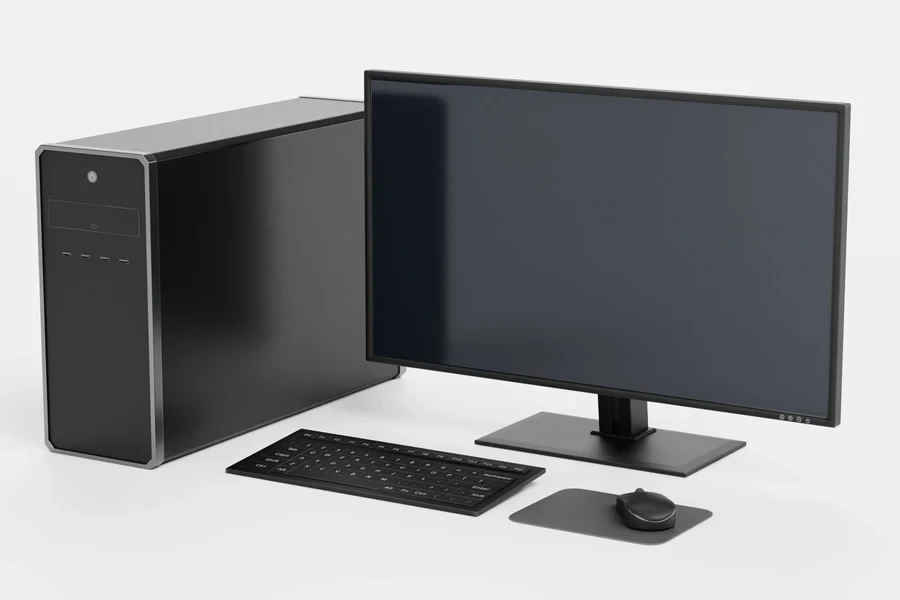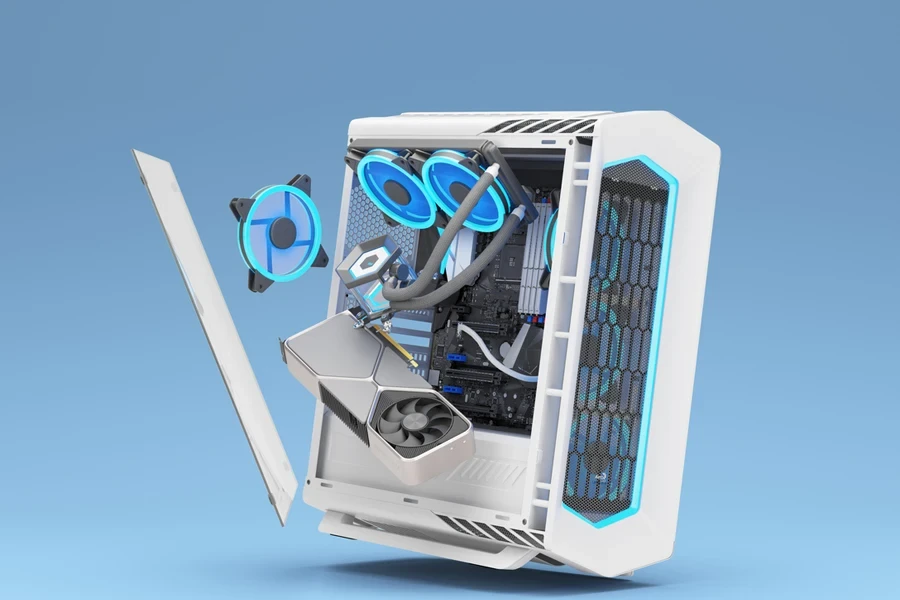In the swiftly evolving tech landscape of 2024, workstations remain pivotal for professionals across various sectors, offering robust solutions to complex computing needs. These high-performance machines empower tasks ranging from intricate data analysis and advanced design to complex simulations, enhancing productivity and facilitating innovation. With the right workstation, firms can leverage cutting-edge technology to maintain competitive edges, ensuring that their computational power aligns with their ambitious project requirements and industry standards. Selecting an optimal workstation is more than an investment in hardware; it is a foundational element for future success in any data-intensive or design-oriented field.
Table of Contents
1. Exploring workstation varieties and their domains
2. Insights into the 2024 workstation market
3. Key considerations for selecting the right workstation
4. Spotlight on 2024’s premier workstations
Exploring workstation varieties and their domains

Powerhouses on the desk: The role of desktop workstations. Desktop workstations are engineered to meet the high demands of professionals across various sectors, including engineering, graphic design, scientific research, and video production. These machines combine advanced processing power with high-end graphics capabilities to handle intensive computational tasks effortlessly. For instance, the HP Z2 Tower G9 offers a solid entry-level option with substantial customization potential, supporting tasks from financial analysis to 3D modeling. Moving up the spectrum, the HP Z8 Fury G5 exemplifies a top-tier workstation, equipped with Intel Xeon processors and multiple GPUs, making it ideal for VFX artists and AI researchers who require formidable computing muscle.
The scalability of these systems allows for configurations that meet specific professional needs, from basic to complex setups. For example, the Falcon Northwest Talon, with its AMD Ryzen Threadripper Pro, delivers exceptional performance at a competitive price point, offering a significant advantage in processing complex datasets and rendering tasks.
Agility meets power: The rise of mobile workstations. The evolution of mobile workstations has made power portable, bringing desktop-class performance to professionals on the move. These devices cater to a range of industries, enabling architects, project managers, and field researchers to carry out intensive tasks directly on-site without compromise. The Lenovo ThinkPad P16, for instance, provides an exemplary balance of performance and mobility, with high-end specs that support everything from CAD applications to data analysis without tethering the user to a desk.
Mobile workstations like the HP ZBook Fury 16 G10 stand out by offering premium specs such as high-resolution displays and robust processing power in a form factor that is easy to transport. These workstations ensure that the mobility required by professionals does not come at the cost of performance, with configurations that rival their desktop counterparts. The Apple MacBook Pro with its M3 Max chip is particularly notable for combining workstation-grade performance with exceptional battery life, appealing to creative professionals who value both power and aesthetics.
Insights into the 2024 workstation market

Innovations shaping the future of workstations: Experts currently value the workstation market at US$ 59.57 billion, and they expect it to reach US $125.55 billion by 2034. They estimate this boost will happen at a 7.7% compound annual growth rate (CAGR) from 2024 to 2034.As workstations continue to evolve, cutting-edge technologies are dramatically enhancing both performance and the user experience. Key among these advancements are the integration of AI-driven functionalities and quantum computing elements that facilitate rapid data processing and analysis. The development of more sophisticated, energy-efficient processors and graphics cards also plays a critical role. These improvements not only enhance the capability of workstations to handle complex simulations and computations but also significantly reduce power consumption and heat generation, thereby increasing their appeal in eco-conscious business environments.
Moreover, advancements in virtual and augmented reality technologies are being leveraged to create more immersive and interactive design and training environments. These technologies enable professionals in architecture, engineering, and entertainment to visualize their work in real-time and in three dimensions, pushing the boundaries of innovation and design.
Demand patterns and buyer profiles: The demand for high-performance workstations in 2024 reflects a broad spectrum of industries and professional needs. Industries such as biotechnology, data analytics, and digital content creation are at the forefront, driving demand for machines capable of handling large datasets and complex algorithms. Within these sectors, professionals are looking for workstations that offer not only raw power but also high reliability and scalability to support future growth.
Professionals in graphics-intensive fields, such as video production and game development, are particularly interested in the graphic capabilities of their systems. They prioritize workstations equipped with the latest GPUs that support advanced rendering techniques and real-time editing of 4K and even 8K video content. Similarly, the rise in remote work and digital collaboration has fueled the adoption of workstations that can support multiple monitors and high-speed networking capabilities to facilitate seamless team collaboration across various locations.
These trends underscore a market that is increasingly diversified yet unified by a common requirement for high performance, reliability, and adaptability to rapidly changing technological landscapes. As companies continue to seek out the most efficient and powerful computing solutions, workstations remain a critical asset in achieving their ambitious technological and business objectives.
Key considerations for selecting the right workstation

Processor power: Decoding core count and speed. When selecting a workstation, understanding the relationship between core count and clock speed in relation to specific software needs is critical. For computational heavy tasks such as 3D modeling or large data set processing, opting for a processor like the Intel Xeon or AMD Ryzen Threadripper Pro, which offer between 8 to 64 cores, becomes essential. These high-core-count processors facilitate multitasking and swift data handling, crucial for software used in scientific research, financial modeling, or graphic design. For example, rendering software or simulation applications perform optimally with higher core counts because they can process multiple threads simultaneously, reducing overall computation time.
Clock speed, which measures how many cycles a processor can execute per second (indicated in gigahertz, GHz), influences how quickly tasks are performed within each core. Workstations like HP’s Z series, which can be equipped with processors that reach speeds over 4 GHz, are particularly adept at handling tasks that require frequent, intensive processing of data, offering quick turnaround times on demanding applications.
Graphics excellence: Choosing the right GPU. Selecting the appropriate GPU is paramount, especially for workstations employed in graphic-intensive fields. GPUs like NVIDIA’s Quadro or AMD’s Radeon Pro are engineered to manage and accelerate graphics rendering and video processing tasks. For instance, NVIDIA’s RTX A5000 series provides substantial power for handling complex visual content, making it ideal for professionals in video editing, animation, and real-time VFX production.
The choice of GPU should be informed by the specific demands of the user’s applications. High-resolution video editing and complex 3D rendering require GPUs with substantial memory and fast processing capabilities to render graphics without latency. For example, real-time rendering of 4K video or detailed 3D environments in software like Unreal Engine or Autodesk Maya is vastly improved by advanced GPUs, which can manage large textures and multiple effects simultaneously without compromising system stability.
Storage and scalability: Planning for future needs. Evaluating storage options and scalability potential is crucial for ensuring that a workstation remains effective over its lifespan. SSDs are recommended for the operating system and applications due to their speed and reliability; they provide quicker boot times and faster data access, which accelerates workflow significantly. For example, workstations configured with PCIe SSDs offer enhanced performance over SATA SSDs, with quicker data transfer rates that are beneficial for applications involving large files, such as video editing or extensive database access.
Moreover, the ability to upgrade a workstation’s storage and memory is essential for adapting to future software developments and increasing data demands. Workstations that allow easy upgrades to RAM and include multiple drive bays offer flexibility for future expansion. It is advantageous to select systems that support these upgrades without the need for complete overhauls, thus extending the useful life of the investment and adapting to changing performance needs.
Professionals must consider these key aspects—processor capability, graphical processing power, and storage scalability—to ensure that their workstation can handle current tasks efficiently while remaining adaptable to future technological advancements. This strategic approach ensures sustained productivity and performance, making it a critical investment for any demanding computing environment.
Spotlight on 2024’s premier workstations

Champions of the desktop arena: Features and performance. The 2024 landscape for desktop workstations showcases models that blend exceptional power with tailored features for specific professional applications. The HP Z2 Tower G9 emerges as a stellar entry-level option, well-suited for a variety of tasks from financial analysis to complex 3D modeling, thanks to its scalable Intel processors that can reach up to the Core i9 K series and support up to 128GB of memory and 48TB of storage. Its versatility is complemented by HP’s proprietary Wolf Security, enhancing its appeal with robust malware protection and virtual machine sandboxing capabilities.
For those needing more intense computational muscle, the Falcon Northwest Talon, equipped with an AMD Ryzen Threadripper Pro, offers an unrivaled combination of performance and value. This model stands out for its ability to handle the most demanding data and content creation tasks with ease, supported by a 64-core processor and significant graphical horsepower with Nvidia RTX 6000 GPUs. It’s particularly noted for its relatively lower cost in comparison to its high-end performance metrics.
On the higher end of the spectrum, the HP Z8 Fury G5 dominates with its dual-Xeon processors and the option to include up to four Nvidia RTX A6000 GPUs. This machine is designed for the most punishing workflows in media, VFX, and AI development, providing not just power but also a highly customizable framework that allows professionals to tailor the workstation to their specific needs over time.
Leading the pack: Top mobile workstations reviewed. Mobile workstations have also seen significant advancements in 2024, with the Lenovo ThinkPad P16 leading as an optimal choice for professionals on the move. It balances high-end performance specifications like Intel Xeon processors and Nvidia RTX A5000 series GPUs with portability, offering a robust platform for CAD applications and other demanding software while facilitating easy mobility.
Another notable contender is the HP ZBook Fury 16 G10, which impresses with its ability to deliver desktop-grade performance in a mobile form. It supports configurations that include cutting-edge components such as 8-core Intel Xeon CPUs and up to 128GB of RAM, making it suitable for complex, graphics-heavy applications on the go. Its high-resolution display and robust build quality ensure that it stands up to the needs of high-stakes environments without compromise.
These mobile units mirror the capability of their desktop counterparts, proving that current technology allows for no compromise on performance in favor of mobility. With options that cater to a range of professional needs and budgets, 2024’s workstation offerings ensure that whether at a desk or on the field, professionals have access to the computing power required to drive their industries forward.
Conclusion
Choosing the right workstation is crucial for maximizing both productivity and performance across various professional domains. As 2024’s models demonstrate, from potent desktops like the HP Z8 Fury G5 to nimble mobile units such as the Lenovo ThinkPad P16, workstations cater to diverse professional needs. Each model offers specific features that align with different computational and graphical tasks, ensuring that businesses can efficiently tackle their unique challenges and drive forward in an increasingly competitive technological landscape.



